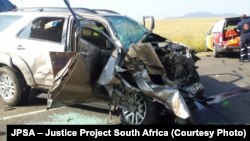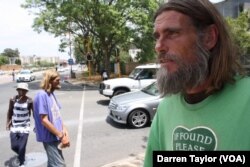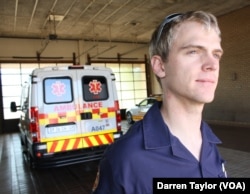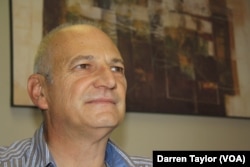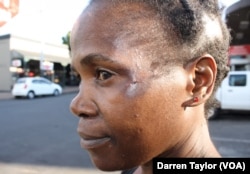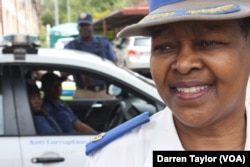Vehicles flash past a homeless man begging at a busy intersection in Johannesburg. The sun has burned gold streaks into his stringy brown hair.
Donovan Hermans lives here, under trees at the side of Empire Road, warmed by filthy blankets reeking of exhaust fumes, cloaked in chemical smog.
He’s often the first person on the scene of the many crashes that happen here.
“I’ve seen bikes come down; bikers [killed]; I’ve seen cars trying to make turns wiped out by buses or [minibus] taxis; hell of a lot taxi accidents here,” said Hermans.
He recently saw a woman killed trying to cross the road.
“She’s walking on the island and her phone rings; she takes it out her pocket, answers her phone, takes one step into the street; bus hits her in the face, smashes her face completely. That bus was going too fast, it couldn’t stop,” Hermans explained.
Disorganization, chaos
On the other side of Johannesburg, a radio crackles as paramedic Victor Voorendyk receives the first emergency call of what he knows will be “another manic day.”
The dispatcher told him: “Please proceed to the November One South [N1 highway] before Malibongwe [Road], for a motor vehicle accident… Two vehicles involved, one patient trapped.”
Voorendyk said two words summarize what he’s seen in eight years on South African roads.
“Disorganization and chaos… People always ask us [paramedics] in public, ‘What’s the worst thing that you’ve ever seen?’ That’s not a question I want to answer…”
His colleague, Ian Watson, has been working the roads for the past 16 years.
“In my opinion, and based on my workload, the scale and intensity of road accidents has increased over the past decade,” he said. “Everything from the pedestrian that walks across the road and gets hit by the car, to the minibus taxis that roll and patients scattered everywhere. It can get very graphic on some days.”
Roads worse than war zones
South Africa’s Justice Project, a non-profit, monitors the country’s traffic system and its implementation of road laws.
Chairman Howard Dembovsky, a former police officer, said the injuries and deaths because of road smashes are a “national tragedy” that the country’s citizens and authorities aren’t taking seriously.
“More people are dying on our roads than die in the Middle East in war-torn countries, per day!” he scoffed.
“Drivers in South Africa are lawless. They speed. They drive under the influence of liquor. They go through red traffic lights. They and their passengers don’t wear seatbelts... Many don’t have valid licenses, their vehicles aren’t roadworthy… And hey, if you get caught by a cop for any of this, you just bribe your way out of trouble.”
The government said about 14,000 people lose their lives in car crashes in South Africa every year.
But independent analysts, like Dembovsky and Carol Smit of the South Africans against Drunk Driving group, dispute this number.
“If you’re looking at the statistics from the mortuaries, it’s more likely 20,000 or 25,000 a year,” said Smit.
The Justice Project said the yearly death toll is “at least” 21,000, based on s analysis. Tens of thousands of others suffer severe and crippling injuries.
Dembovsky said South Africa’s official annual road death toll is too low for a good reason: Its Department of Transport (DOT) only records “immediate” fatalities, and is failing to register the deaths of people who perish from injuries up to 30 days after a traffic accident — even after it pledged to do so in 2010.
Dembovsky said “weak” statistics mean South Africa cannot successfully confront the crisis on its roads. “If you’re going to have a scientifically-based road safety strategy, you need reliable statistics. The consistent absence of this is a big problem because you need a holistic view of what’s going on in order to collect correct data to plan the necessary interventions.”
DOT spokespeople did not respond to repeated requests for comment about the statistics and road safety in general in South Africa.
The WHO’s 2015 Global Road Safety Report, based on 2013 statistics provided by governments and released in October last year, rated Africa’s roads the world’s deadliest. The continent is home to 40 of the 50 countries with the highest road death tolls.
The WHO put South Africa's road fatalities per 100,000 people at just over 25, a little below the African average of 27.
Dembovsky questions that number but said WHO is right in its assertion that South Africa’s “very good” traffic laws aren’t being properly enforced.
“Law wise, South Africa is right up there with the rest of the world. Enforcement wise, South Africa is right down there with Kenya, with Nigeria, not least because many of our law enforcers are corrupt,” he said.
Senior Johannesburg Metro Police officer, Edna Mamonyane, said police don't have enough personnel to properly enforce the laws. “We’re doing our best, but manpower, that’s the issue," she said. "We need more officers on the roads.”
According to Justice Project research, there are now 11 million licensed drivers in South Africa.
“We only have 120,000 kilometers of paved roads," Dembovsky said. "Crowding so many millions of vehicles into that, without strong law enforcement and good planning, is looking for even bigger trouble than we’re already in.”




